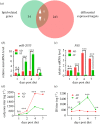Helicoverpa armigera miR-2055 regulates lipid metabolism via fatty acid synthase expression
- PMID: 35232249
- PMCID: PMC8889172
- DOI: 10.1098/rsob.210307
Helicoverpa armigera miR-2055 regulates lipid metabolism via fatty acid synthase expression
Abstract
Insect hormones and microRNAs regulate lipid metabolism, but the mechanisms are not fully elucidated. Here, we found that cotton bollworm larvae feeding on Arabidopsis thaliana (AT) leaves had a lower triacylglycerol (TAG) level and more delayed development than individuals feeding on artificial diet (AD). Association analysis of small RNA and mRNA revealed that the level of miR-2055, a microRNA related to lipid metabolism, was significantly higher in larvae feeding on AT. Dual-luciferase reporter assays demonstrated miR-2055 binding to 3' UTR of fatty acid synthase (FAS) mRNA to suppress its expression. Elevating the level of miR-2055 in larvae by agomir injection decreased FAS mRNA and protein levels, which resulted in reduction of free fatty acid (FFA) and TAG in fat body. Interestingly, in vitro assays illustrated that juvenile hormone (JH) increased miR-2055 accumulation in a dosage-dependent manner, whereas knockdown of Methoprene tolerant (Met) or Kruppel homologue 1 (Kr-h1) decreased the miR-2055 level. This implied that JH induces the expression of miR-2055 via a Met-Kr-h1 signal. These findings demonstrate that JH and miRNA cooperate to modulate lipid synthesis, which provides new insights into the regulatory mechanisms of metabolism in insects.
Keywords: Helicoverpa armigera; development; juvenile hormone; lipid metabolism; microRNA.
Conflict of interest statement
The authors declare that they have no competing interests.
Figures






Similar articles
-
Juvenile hormone induces methoprene-tolerant 1 phosphorylation to increase interaction with Taiman in Helicoverpa armigera.Insect Biochem Mol Biol. 2021 Mar;130:103519. doi: 10.1016/j.ibmb.2021.103519. Epub 2021 Jan 13. Insect Biochem Mol Biol. 2021. PMID: 33450383
-
Involvement of Methoprene-tolerant and Krüppel homolog 1 in juvenile hormone-signaling regulating the maturation of male accessory glands in the moth Agrotis ipsilon.Insect Biochem Mol Biol. 2021 May;132:103566. doi: 10.1016/j.ibmb.2021.103566. Epub 2021 Mar 17. Insect Biochem Mol Biol. 2021. PMID: 33741430
-
Methoprene-tolerant 1 regulates gene transcription to maintain insect larval status.J Mol Endocrinol. 2014 Aug;53(1):93-104. doi: 10.1530/JME-14-0019. Epub 2014 May 28. J Mol Endocrinol. 2014. PMID: 24872508
-
Dissecting the role of Krüppel homolog 1 in the metamorphosis and female reproduction of the cotton bollworm, Helicoverpa armigera.Insect Mol Biol. 2018 Aug;27(4):492-504. doi: 10.1111/imb.12389. Epub 2018 May 2. Insect Mol Biol. 2018. PMID: 29719076
-
Methoprene-tolerant and Krüppel homolog 1 are actors of juvenile hormone-signaling controlling the development of male sexual behavior in the moth Agrotis ipsilon.Horm Behav. 2023 Apr;150:105330. doi: 10.1016/j.yhbeh.2023.105330. Epub 2023 Feb 13. Horm Behav. 2023. PMID: 36791650 Review.
Cited by
-
The accumulation of modular serine protease mediated by a novel circRNA sponging miRNA increases Aedes aegypti immunity to fungus.BMC Biol. 2024 Jan 17;22(1):7. doi: 10.1186/s12915-024-01811-6. BMC Biol. 2024. PMID: 38233907 Free PMC article.
-
The Key Role of Fatty Acid Synthase in Lipid Metabolism and Metamorphic Development in a Destructive Insect Pest, Spodoptera litura (Lepidoptera: Noctuidae).Int J Mol Sci. 2022 Aug 13;23(16):9064. doi: 10.3390/ijms23169064. Int J Mol Sci. 2022. PMID: 36012329 Free PMC article.
-
Wds-Mediated H3K4me3 Modification Regulates Lipid Synthesis and Transport in Drosophila.Int J Mol Sci. 2023 Mar 24;24(7):6125. doi: 10.3390/ijms24076125. Int J Mol Sci. 2023. PMID: 37047100 Free PMC article.
-
Developmental Expression Patterns of miRNA in Mythimna separata Walker (Lepidotera: Noctuidae).Genes (Basel). 2025 Feb 19;16(2):234. doi: 10.3390/genes16020234. Genes (Basel). 2025. PMID: 40004562 Free PMC article.
-
Thermal Stress Induces Metabolic Responses in Juvenile Qingtian Paddy Field Carp Cyprinus carpio var qingtianensis.Animals (Basel). 2022 Dec 2;12(23):3395. doi: 10.3390/ani12233395. Animals (Basel). 2022. PMID: 36496916 Free PMC article.
References
Publication types
MeSH terms
Substances
LinkOut - more resources
Full Text Sources
Research Materials
Miscellaneous

